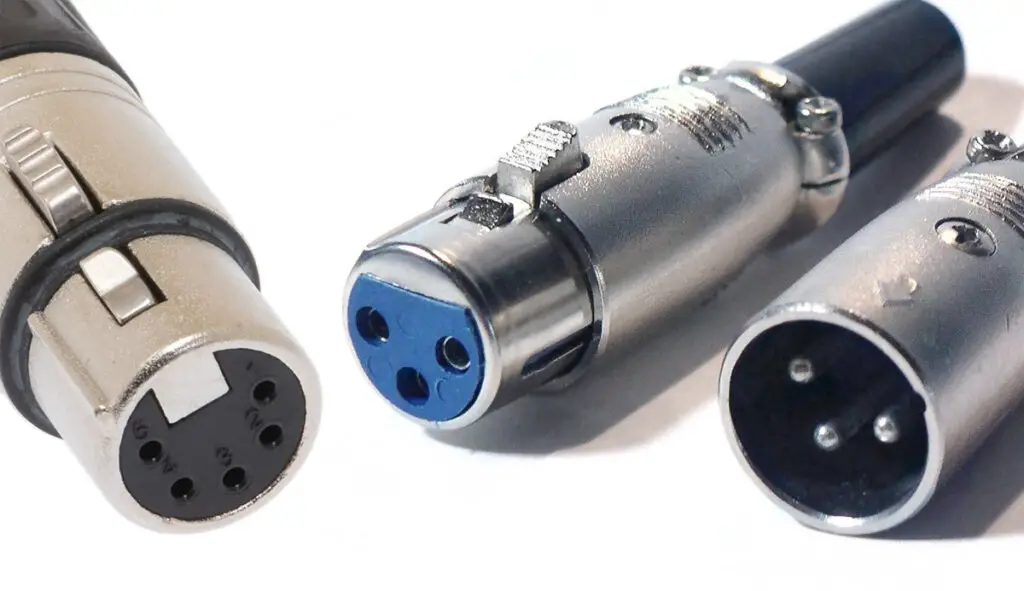The world of professional audio equipment relies heavily on various connectors to ensure high-quality signal transmission and minimal interference. Among the numerous connector types, XLR connectors have become the industry standard for balanced audio signals.
While the 3-pin XLR connector is the most common variant, used primarily for mono audio signals, the lesser-known 5-pin XLR connector offers additional versatility, accommodating stereo audio signals and intercom systems, but primarily lighting applications.
Understanding the differences between these XLR connector types and their specific applications is helpful for anyone working with professional audio and lighting equipment, ensuring seamless integration and optimal performance.

Are XLR Connectors Stereo or Mono?
XLR connectors are typically used for transmitting balanced mono audio signals. They feature three pins: one for the ground (Pin 1), one for the positive signal (Pin 2), and one for the negative signal (Pin 3). The balanced signal helps to minimize noise and interference in the audio signal.
However, it is possible to use two separate XLR connectors for a stereo signal, with one connector for the left channel and one for the right channel. This is common in professional audio setups, where individual XLR cables are used for each channel to maintain a high-quality signal.
Can XLR Be Stereo?
A 3-Pin XLR connector itself is not inherently stereo, as it is designed for balanced mono audio signals. However, you can use a pair of XLR connectors and cables to carry a stereo signal by dedicating one connector to the left channel and another to the right channel. In professional audio environments, this is a common practice to ensure high-quality signal transmission with minimal noise and interference.
Technically, it is possible to create a custom cable that uses a single XLR connector to carry both the left and right channels of a stereo signal by assigning different pins to each channel. However, this setup is non-standard, and you would lose the benefits of balanced audio, which is one of the primary reasons for using XLR connectors in the first place.
What Is The Difference Between 5-Pin And 3-Pin XLR?
The main difference between a 3-pin XLR and a 5-pin XLR connector is the number of pins and their respective applications:
- 3-pin XLR: This is the most common type of XLR connector and is primarily used for transmitting balanced mono audio signals. The three pins have specific functions:
- Pin 1: Ground (shield)
- Pin 2: Positive (hot) signal
- Pin 3: Negative (cold) signal
The balanced signal helps to minimize noise and interference in the audio signal. 3-pin XLR connectors are widely used in microphones, mixers, and other professional audio equipment.
- 5-pin XLR: This type of XLR connector has five pins and is primarily used for transmitting DMX512 data for lighting control, as well as stereo audio signals in some cases. In lighting control, the 5-pin XLR connector allows for a more complex data transmission between lighting fixtures and controllers. For stereo audio applications, the pin assignments are:
- Pin 1: Ground (shield)
- Pin 2: Left channel positive (hot) signal
- Pin 3: Left channel negative (cold) signal
- Pin 4: Right channel positive (hot) signal
- Pin 5: Right channel negative (cold) signal
This configuration allows for the transmission of balanced stereo audio signals using a single 5-pin XLR connector, although it is less common than using two separate 3-pin XLR connectors for stereo signals.
The primary difference, therefore, is the number of pins and their specific applications in audio or lighting systems.
What Audio Devices Have 5-Pin XLR Connectors?
5-pin XLR connectors are relatively uncommon for audio devices compared to the standard 3-pin XLR connectors. However, there are some specific audio applications and devices where you may encounter 5-pin XLR connectors:
Stereo microphones: Some professional stereo microphones use a single 5-pin XLR connector to output both the left and right channels of a stereo signal. In this case, an adapter or breakout cable is often used to split the stereo signal into two separate 3-pin XLR connectors for connecting to a recording device or mixer.
Intercom systems: Professional wired intercom systems, such as those used in broadcast or live event production, sometimes utilize 5-pin XLR connectors. This is done to accommodate additional functionality, such as separate channels for communication and program audio.
Audio distribution: Some high-end audio distribution systems, like those used in large-scale installations, might use 5-pin XLR connectors to transmit balanced stereo audio signals over long distances, though this is less common.
Ambisonic microphones: Some ambisonic microphones, which capture 360-degree sound fields, may use a 5-pin XLR connector to output multiple audio channels. However, it’s worth noting that many ambisonic microphones use other multi-pin connectors, such as 12-pin or even higher, depending on the number of channels they output.
In general, 5-pin XLR connectors are relatively rare in audio devices, and most professional audio equipment uses the more common 3-pin XLR connectors for balanced mono signals.
Conclusion
XLR connectors play a pivotal role in the professional audio and lighting industry, delivering high-quality signal transmission while minimizing noise and interference.
The 3-pin XLR connector, widely used for balanced mono audio signals, has become an indispensable component in various audio devices such as microphones, mixers, and more.
Although less common, the 5-pin XLR connector serves specialized purposes, providing solutions primarily for lighting control applications.
By understanding the differences and unique uses of these connector types, professionals in the audio and lighting industries can ensure the best possible performance and the highest quality results in their projects.


